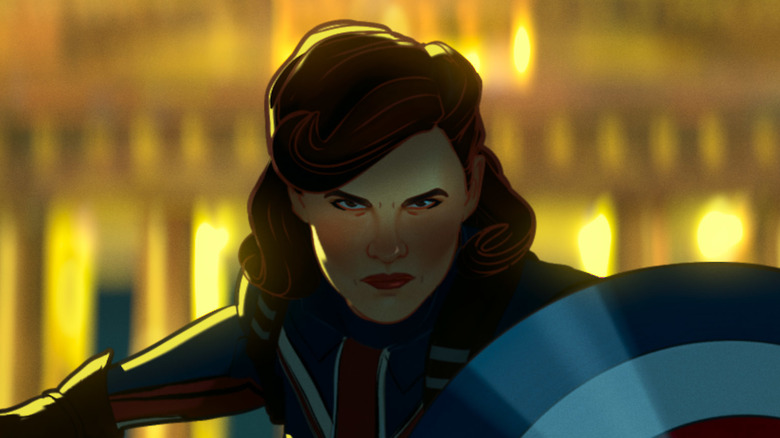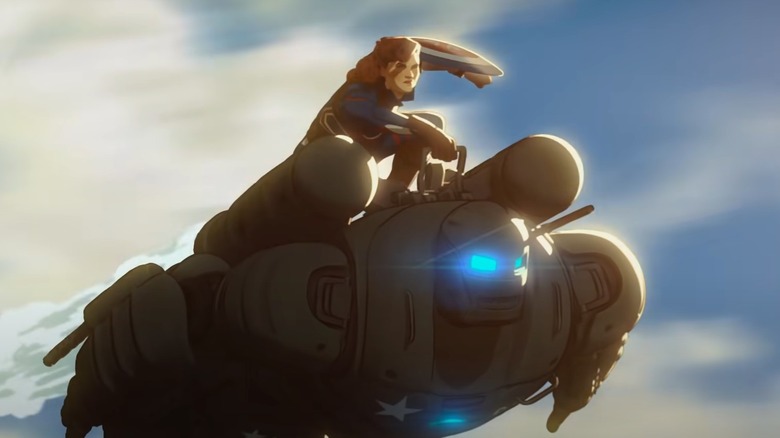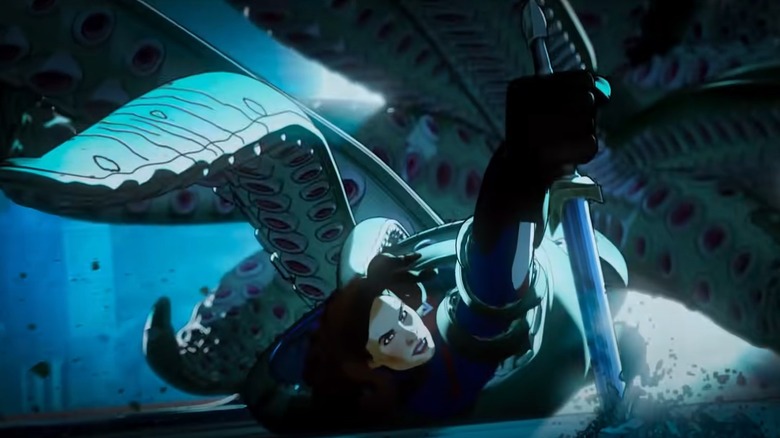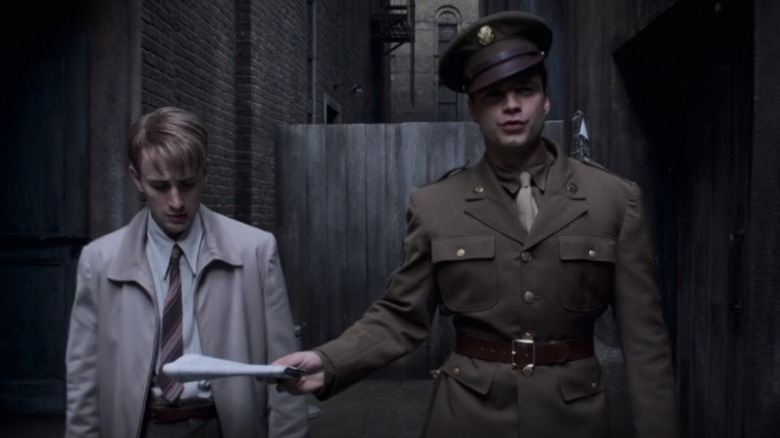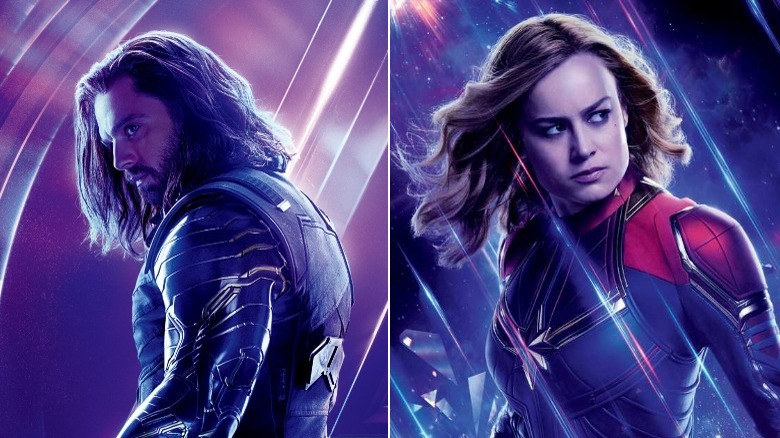What If...? Episode 1 Explained
Ushered in on the smokey, barrel-aged smoothness of Jeffrey Wright's vocal cords, a familiar question rocks the Marvel Cinematic Universe: "What If?"
In this case, the question applies to the case of one Margaret Elizabeth Carter: S.H.I.E.L.D. cofounder, secret operative, and constant recipient of isn't-she-dreamy glances from Steve Rogers. "What if," the premiere episode of the program asks, "Peggy Carter had stayed in the room when it came time to pump Rogers full of performance-enhancing drugs?"
The answer, it seems, is chaos. During Hydra's attack on the Super Soldier program by undercover members of the State Department, as seen originally in "Captain America: The First Avenger," Peggy's slightly altered proximity changes the whole game. Steve is shot before he can receive the life-altering injections and, mercilessly perforated by luger rounds, lies bleeding on the floor. Carter drops the saboteur and tells Steve to stay put. He obliges. He can wince and slowly bleed out all day.
Short on time and bereft of other options, Carter climbs into the transformation chamber and gets pumped full of serum. She emerges transfigured, a towering goliath of British strength, receives a shield all her own adorned with the Union Jack, and almost immediately starts beating her alternate universe American counterpart at the "winning World War II" game, nabbing the Tesseract from Arnim Zola without much muss or fuss.
But that isn't all that goes down in "What If...?" episode one — here's the rest of the episode explained.
Captain Carter of Wars
Steve rehabilitates and, with the help of Howard Stark's engineering prowess, starts piloting a suit of Hydra Stomper armor, powered by the Allies' recently acquired Tesseract.
Philosopher Alan Watts used to say that all of existence is a dance — frogs do a frog dance, leptons do the lepton dance. Newly outfitted in a plate-armored mech suit, powered by an Infinity Stone and an insatiable patriotic go-get-em attitude, Steve Rogers enters the fray and joins Captain Carter in the wholesale Nazi slaughter dance. There's music and everything.
But the fascist-smashing good times can't last forever, and Captain Carter finds herself at her lowest point right around the end of the story's second act. During "Operation: Where Eagles Dare," Steve is apparently killed in action thanks to a veritable Wile E. Coyote stash of dynamite hidden on the Hydra train that he's in the process of taking down a peg — the same train that Bucky might have ominously fallen from in another timeline, setting the stage for decades of mind wipes and brooding and greasing up his arm with WD-40.
Peggy interrogates an imprisoned Arnim Zola, learning that the Red Skull is planning to bust out an interdimensional champion at Castle Krake — that's German for "octopus," thank you very much — in the Black Forest. Accompanied by the Howling Commandos, Howard Stark, and a notably amputation-free Bucky Barnes, Cap does like Billy Crystal said in "The Princess Bride" and has fun storming the castle.
A betentacled farewell from WWII's greatest What If hero
Inside of Castle Krake, our heroes discover skullduggery — Red Skullduggery. The crimson creep has surprises a-plenty up his sleeve. Not only has he recovered the Tesseract from the Hydra Stomper armor, he's retrieved the armor itself, as well as the tiny kid from Brooklyn that once piloted it. He opens a portal, summoning a Lovecraftian horror from beyond the veil of existence to bring about Hydra's reign of terror. The terrible beastie has more than a little in common with the classic Marvel monster Shuma-Gorath, minus the giant eye and with the addition of a "Stranger Things"-style Demogorgon mouth at the center of its writhing self.
But as has often been said, he who lives by the unspeakable cephalopod abomination must also die by the unspeakable cephalopod abomination, and the Red Skull gets smeared into a Red Paste, hoisted by his own extradimensional tentacle. Stark does like a good sci-fi super scientist is supposed to do and hits some buttons, trying to reverse the polarity hard enough to make the rapidly-expanding squid bits go back to where they came from, but to no avail. Steve Rogers, now rescued and back in his jury rigged, patch-job-powered armor, runs out of juice before he can make much of an impact. The only solution to the tentacle problem is for Captain Carter to personally shove the eldritch horror back from whence it came. She disappears into the unknown, promising Steve a dance on her way out. Everything fades to black.
Almost 70 years later, Carter returns, flanked by cuts of jumbo squid, out of a Cosmic Cube-induced portal at what sure looks like the Joint Dark Energy Mission Facility in the Mojave Desert from 2012's "Avengers." She is informed of her anachronistic lot in life and mourns the loss of a life with the skinny little man that she loved all those years prior. A super soldier, plucked from history, stands ripe with promise of becoming the hero of a new era. It's all terribly familiar.
So what did we learn here today?
The dark side of What If? and its alternate history
A lot is implied by the universe presented in the first episode of "What If...?"
First off, Howard Stark was capable of coming up with an Iron Man suit capable of harnessing the power of the Tesseract, potentially shifting the course of human civilization and, more importantly, insinuating that concepts like glowy-chest power armor are hereditary.
The really intriguing question that the episode leaves open is, "What would a world without Peggy Carter look like?" We know that Agent Carter was instrumental in the creation of S.H.I.E.L.D. during the 20th century of the MCU proper — an organization that itself became an unknowing incubation chamber for Hydra. The Dark Energy lab seen at the end of the episode looks less well-manned than the one from "Avengers." Maybe it's a coincidence, or maybe Hydra got more of a foothold without Peggy around to keep a weather eye on things. We don't see anything about the world outside the lab circa 2012, but it's hard to imagine that things went better without the supervision of one of the Allied Forces' most legendary agents, even with Bucky and Steve set up to stand in for her.
No Winter Soldier, no Captain Marvel
Without Bucky to use as their Vibranium-armed super soldier, Hydra wouldn't have had their go-to agent available to kill Howard and Maria Stark on December 16, 1991. Without his father's absence, Tony — seen in glorious B.A.R.F. at the beginning of "Captain America: Civil War" — might not have had any reason to rise to the occasion and learn how to take the wheel of his old man's company.
What's worse, with Iron Man-adjacent technology entering into play some six decades early, a whole new set of potential travesties would be lined up. Assuming that the U.S. Government retained the rights to the invention, the course of manned warfare on Earth would have drastically changed, and an international race to create powered suits would have kicked off during the Cold War, opening the door to mid-20th century versions of the Crimson Dynamo, Titanium Man, and Iron Monger.
Then again, maybe Howard Stark held onto the technology for himself and went into business selling Iron Man suits, powered by Tesseract energy, with the Cube no longer destined to sit in mothballs for decades in the wake of his up-close comprehension of its potential. Maybe Howard used the Tesseract and its physics-defying abilities to finally realize that new element (described and realized in the climax "Iron Man 2") that he'd had his eye on but couldn't create thanks to the limitations of his day. Dozens of conflicts across U.S. history would suddenly be shifted thanks to the presence of legions of Iron Men. Howard, drunk with power and also probably a little bit drunk with alcohol, refuses to relinquish the Tesseract to Project P.E.G.A.S.U.S., halting the creation of Captain Marvel and dooming the Earth upon the arrival of Thanos. The implications are countless.
Or maybe we're overthinking a cartoon. We do that sometimes. And with that in mind, what kind of timeline altering shenanigans will we have to contemplate when "What If...?" episode 2 drops next week?
